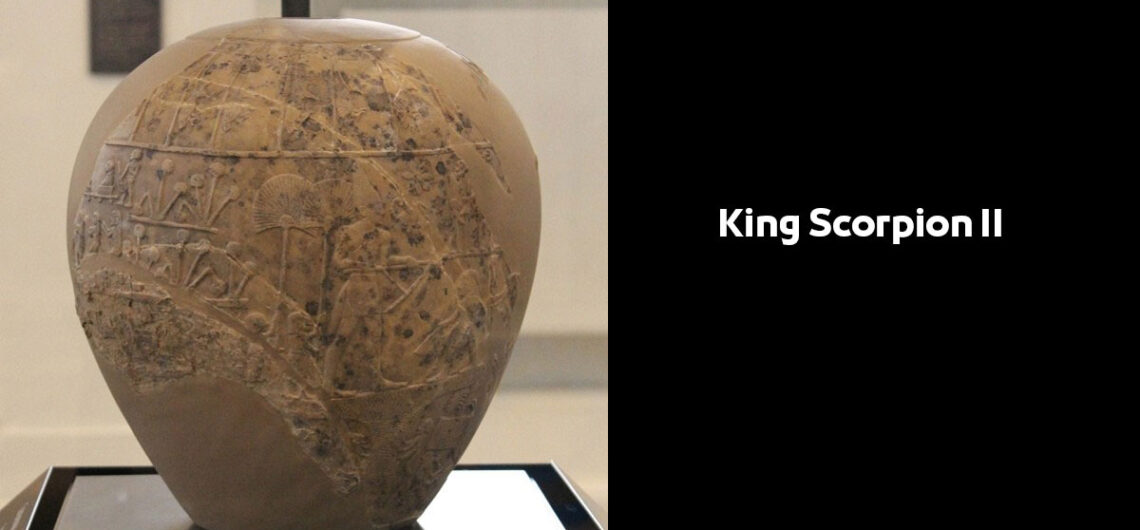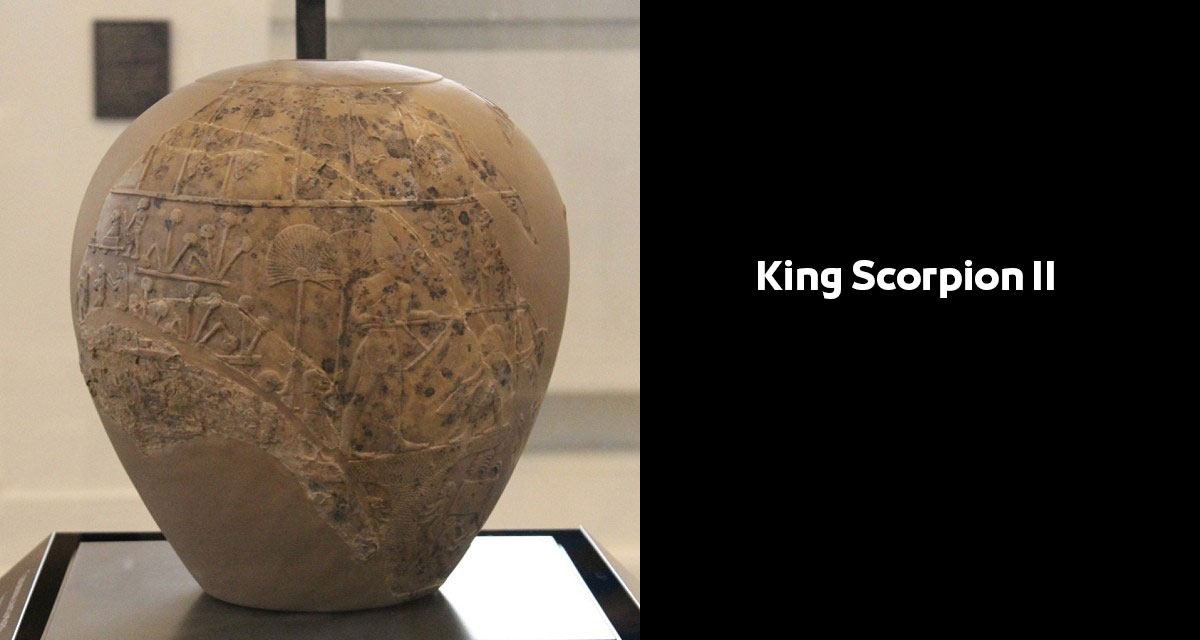King Scorpion II or Selk or Weha “King Scorpion” | The most famous Egyptian Pharaohs kings in the Dynasty 0 in on the civilization of Ancient Egypt in the Predynastic Period.
Discover the history of the Pharaonic civilization and historical facts about the Pharaonic king, what are the most important discoveries and secrets of his private life, and more about Ancient Egypt History.
King Scorpion II Facts:
- The last king of the Egyptian Dynasty 0, in the pre-dynastic era of the Naqada III civilization.
- Governor of the regions of Upper Egypt and regions in southern Egypt, as in the Geography of ancient Egypt.
- Period of rule: 3200 years BC.
- Date of death: approximately 3280 BC.
- The name of King Scorpion II has been linked to the most famous ancient Egyptian deities, God Serket, a symbol of fertility, nature, and Medicine in ancient Egypt in the Ancient Egyptian religion Pharaohs.
- Egyptian Mythology & the legends of the Pharaohs tell that King Scorpion II was a distinguished leader and military man who was distinguished by his courage in combat and a lover of goodness and justice. He united with the people to confront an unjust and corrupt ruler of one of the southern regions of Egypt and defeated him. He ruled several regions and applied the Law in Ancient Egypt. He was symbolized by the god Maat, the symbol of truth and justice in Egypt. Old.
- King Scorpion ruled after the death of King Ka “Sekhen”, Then he was followed in the rule of ancient Egypt by King Narmer, the unifier of Upper and Lower Egypt, known historically as “Mina, the unifier of ancient Egypt” and the founder of the First Dynasty of Egypt, so that Egypt began to enter the rule of the Pharaohs in the era of the Dynasties of ancient Egypt.
- So far, the Mummy and the Pharaonic Ancient Egyptian Coffins of the King Scorpion II have not been found, or even his burial place or tomb has been discovered.
- The real name of the Pharaoh is Sarkat in Ancient Egyptian Language, and his inscriptions translate to King Scorpio II, which differs from King Scorpion I of the Egyptian Dynasty 00.
Achievements:
- Carrying out military campaigns to fight Egypt’s enemies from the south, especially the Nubia region and Sudan.
- Interest in developing Agriculture in Ancient Egypt and irrigation in ancient Egyptian civilization.
- King Scorpion II was interested in establishing the idea of unifying the regions and provinces of Upper and Lower Egypt and becoming one state under the leadership of one ruler, as in the traditions of Ancient Egyptian Government.
Pharaonic antiquities of King Scorpion II:
- Group of Pharaonic Egyptian Antiquities was discovered in Nekhen “Hierakonpolis, el-Kōm el-Aḥmar“, Which consider the most important Egypt Archaeological Sites tell us the history of the King Scorpion II. The artifact, “The Scepter of the Second Scorpion Macehead,” was discovered among the Egyptian Monuments in the temple of Hierakonpolis, “the oldest Egyptian Temples,” after digging and excavation. As part of a team of archaeologists and Egyptologists between 1897 and 1898 AD.
- The scepter of King Scorpion II was discovered by Egyptology and archaeologists James Edward Quibell and Frederick William Green. It contains inscriptions and drawings of King Scorpion II, showing that he was rulers of the city of Nekhen in southern Egypt.
- A pear-shaped stone cone “Second Scorpion Macehead”, called the “fighting pin or the King Scorpion II cone.” The head of the cone is 32 cm high and 25 cm in diameter. It is engraved with a drawing and scenes of the king holding an ax to hit the ground with to start a new agricultural season in ancient Egypt.
- A group of small ivory teeth was discovered containing scenes of the King Scorpion II.
- The English Egyptologist and archaeologist Dr. Flinders Petrie and Dr. Siegfried Schott are considered the first research team interested in studying the details and history of the life of King Scorpion.
Second Scorpion Macehead:
- King Scorpion II was drawn wearing the crown of the provinces of Lower Egypt and wearing the royal Clothing in ancient Egypt, which is a short robe that covers half of the body up to the knee. In addition, the king was holding an ax with which he struck the ground to start the agricultural season or celebrate agricultural Festivals in Ancient Egypt within the ancient Pharaonic holidays.
- The scenes contain a drawing of flowers symbolizing the Pharaonic king’s title as the ruler of Lower Egypt, in addition to a sculpture of several banners containing hanging dead roach birds, representing the regions and cities controlled by the Scorpion King, which indicates the prolongation of the art of Sculpture in Ancient Egypt.
- The king was also drawn sitting on the throne of ancient Egypt, with the God Nekhbet, above his head. In front of the king stood a group of slaves carrying flags, and behind him were nobles and priests, indicating the formation of government and Social Structure in Ancient Egypt.
- Some layers of the Second Scorpion Macehead were destroyed and worn out and were restored and are now displayed in the historic Ashmolean Museum in Oxford, England.
Egyptologists’ theories:
- There are speculations and theories that say that tomb B50, among the tombs of Umm El Qa’ab Tombs in Abydos, Sohag, belongs to King Scorpion II, but there is no strong evidence yet, and research is still underway to discover the secrets and burial place of King Scorpio II.
- There are many speculations and theories from Egyptologists that the flags in the scorpion’s funnel symbolize the delta region on the banks of the Nile River, which expresses the king’s victory over enemies such as the Libyans or the Nubians from the south.
- Many Egyptologists believe that the king waged many wars on the territories of the city of Naqada in southern Egypt in 3250 BC.
- A group of Pharaonic Serekh and pottery vessels were discovered, in addition to the discovery of the heads of Pharaonic scepters inside the temple of the city of Nekhen, “the ancient Temple of Hierakonpolis” containing inscriptions and sculptures of a scorpion, believed to be attributed to King Scorpion II, who was wearing the white crown.
Hurghada Excursions Lovers, Best Travel Agency in Hurghada to provide daily tours to visit the Tourist attractions of Luxor by Hurghada to Luxor Tours and Hurghada to Pyramids Trips. Book online when you come to Hurghada, El Gouna, Sahl Hashish, Makadi Bay, Soma Bay, Egypt.

